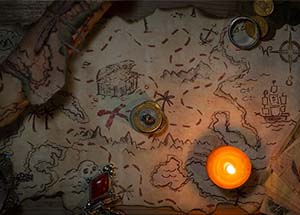Finding the Hidden Treasure in Every Employee
By Ron Price
Podcast Episode 78
As a leader, developing and coaching others is a necessary skill in my arsenal. Supporting professional growth in others, to me, feels like finding hidden treasure. I can know you have potential, but to help you, I need to discover what exactly it is and what the best pathway for you develop that potential.
That’s why when I begin coaching someone new, I always say, “You know, 90% of the success we’re going to have working together is credited to you. I only get 10%. You get 90% because it’s YOUR potential, not mine! It’s who you are and what you decide to do to become the best version of yourself that’s going to create results.”
Coaching and development as a core competency of leadership really means working to bring out the best in those around us in the workplace. As a leader, one of your big jobs is to think about, explore, and identify unrealized potential in your employees—to see the trajectory of where they could go if they meet their greatest potential.
Sometimes it might be helping someone to overcome a problem or work on a weakness. But, in reality, you should spend about 70-80% of your energy, time, and focus with employees on further developing and creating opportunities for their strengths and only 20-30% of time on their weaknesses.
A lot of times, this is where leaders get stuck—they spend so much time trying to fix people, but that’s not where an employee’s greatest potential is. It’s understanding someone’s unique traits and helping them grow those traits to meet their potential. I think great leaders often see this before an individual does. They can identify what the person is capable of becoming and guide them through that process.
There are plenty of tools and skills you can use to begin identifying that potential. Assessments can create a map of a person’s strengths and give a lot of insights that people sometimes intuitively know, but don’t see as clearly as they could. Self-awareness is crucial here because all growth begins with self-awareness. But these assessments also help you understand a person’s behavioral style, their underlying driving motivators, and how they make decisions and judgement calls. You can also see their level of mastery of leadership skills, their emotional intelligence, and how they relate to stress.
These tools all give a clearer picture of an individual as you begin the coaching process—but the skills around those tools are what matter most in guiding and coaching your employees.
Listening is the first place to begin. You need to be able to gather a clear understanding of someone’s potential to create the basis on which you develop and coach them. Great listening is the ability to identify how a person is perceiving their current circumstances, their future potential, and even what’s happened to them in the past. You need this baseline of understanding about how someone thinks and sees their situation. Once you have that, you can listen for what they want their situation to be, where they want to go, what they want to accomplish, and draw it out. Doing this helps them understand how their current behaviors and actions are either helping or hurting them on the way.
Awareness is critical. Once you see someone’s potential, you have to help them see it. Meaning, you need the ability to help them create awareness about themselves, what their unique potential is, and how they could develop it. To do this, your mentee needs to understand their role, their job, and the relationship between what they do well and what their job asks for—and these are not always aligned. They also should be aware of how they fit into the culture of the organization and connect with their team. This is crucial. Sometimes people aren’t developing the way they should because they are in the wrong environment or on the wrong team. One thing that will always hurt an employee is having them in a job that doesn’t play to their strengths.
Planning is also an essential skill as you guide employees through the growth and development process. Creating pathways with accountability and clarity will give them the confidence to reach their goals and see how they are going to get there with specific and measurable achievements along the way. It’s a growth pathway that has enough structure but isn’t overly structured.
Feedback throughout the process is the final skill, and one that so many leaders are nervous about but that is an area rich with opportunity. Research from the University of Washington gives us a very simple formula: for every one piece of corrective feedback, also share three pieces of positive feedback. Catch people doing something right—tell them what they’re doing well. It gives them a sense of security and safety but makes them want to keep growing.
As a leader, you can tell your employees what to do you based on your strategy and goals, but when you see somebody begin to see potential in themselves that they haven’t seen before, it’s one of the most rewarding experiences. You helped somebody see something about themselves that they wouldn’t have seen otherwise. You helped them see potential and turn it into performance. Developing these four skills will help you build up that core leadership competency of coaching and development.
Header image by Nadjib BR of Unsplash.


